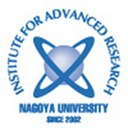IAR-Nagoya
Nagoya University’s Institute for Advanced Research was established according to the University’s Academic Charter in 2002 to produce internationally recognized academic research of the highest caliber, and to contribute to society through the research achievements at the Institute. Nagoya University was a leader among Japanese universities in creating such a new academic organization. To promote the academic development of Nagoya University, the Institute for Advanced Research has three principal functions:
- As an academy within the University, the Institute communicates excellence in research to members of the University.
- By providing substantial support to research of international excellence, the Institute contributes to the improvement of quality of research across the University.
- By actively supporting the independence of outstanding young researchers, the Institute nurtures leaders of the next generation for the University.
(from http://www.iar.nagoya-u.ac.jp/~iar)
In 1871, after the Meiji Restoration, Nagoya Prefecture (formerly the Nagoya Domain), under the guidance of Keisuke Ito and other pioneers from the Nagoya Domain's Smallpox Vaccination Clinic, established the Temporary Hospital and School, which is said to have been the forerunner of today's Nagoya University, to spread Western medicine and cultivate medical practitioners. After a few twists and turns, the hospital and school were renamed the Aichi Medical School in 1881. In 1903 it was renamed the Aichi Prefectural Medical College, and in 1920 it became the Aichi Medical College.
In 1908, the Eighth Higher School was established in Yobitsugi-cho in Aichi County (now the city of Nagoya). This school was the predecessor of the University's former Faculty of Liberal Arts. In 1920, Yobitsugi-cho also became home to Nagoya Commercial College, predecessor of the University's School of Economics.
The establishment of a "comprehensive" university in Aichi Prefecture, and in particular the city of Nagoya-- which had grown into one of the largest cities in Japan--was something that the local residents wanted, and they continued to press the government for a long time. In 1931, the management of the Aichi Medical College was transferred to the national government, making way for the establishment of the Nagoya Medical College. In 1939, the expectations of the public were finally met when Nagoya Imperial University became a reality. The huge cost of establishing the university was completely covered by donations from Aichi Prefecture.
Nagoya Imperial University was established with two schools, the School of Medicine and the School of Science and Engineering. In 1942, the School of Science and Engineering was divided into the School of Science and the School of Engineering. The following year, the Research Institute of Aeronautical Medicine was established. The escalation of the war led to air strikes on Nagoya that severely damaged the University by the time the war came to an end in August 1945.
Amidst post-war democratization, construction and recovery, the Research Institute of Aeronautical Medicine was abolished and the Research Institute of Environmental Medicine was founded in 1946. In October 1947, the name of the university was changed to Nagoya University (under the old education system), and then in 1948, the School of Letters and the School of Law and Economics were founded, thus making Nagoya University a comprehensive university.
Educational reforms in 1949 led to the launching of Nagoya University under the new education system. The new Nagoya University was made up of the School of Letters, School of Education, School of Law and Economics, School of Science, School of Medicine, School of Engineering, the Research Institute of Environmental Medicine and the Research Institute of Atmospherics (the current Solar-Terrestrial Environment Laboratory). At the same time, it also included other schools such as the Eighth Higher School, Nagoya Economic College (the old Nagoya Commercial College), Okazaki Higher Normal School (founded in 1945; predecessor to the School of Education). Nagoya University continued to expand as a comprehensive university, strengthening its foundations by dividing of the School of Law and Economics into two separate schools in 1950, followed by the establishment of the School of Agricultural Sciences in 1951. The first graduate school was established under the new education system in 1953. With the founding of the graduate schools of Medicine and Agriculture in 1955, all of the undergraduate departments had now been paired with graduate schools.
Despite the tight finances and severe lack of materials after the war, faculty, staff, students and graduates combined their efforts to recover from the war and set about concentrating the disparate schools in Higashiyama. The charity of private organizations saw the long-sought-after auditorium and library built in Higashiyama, with the Toyoda Auditorium, a symbol of the university, being completed in 1960 followed by the Furukawa Library (now the Furukawa Hall) in 1964. Research organizations were also expanded with the establishment of the Institute of Plasma Physics (now known as the National Institute for Fusion Science) in 1961 and the Water Research Institute in 1973.
From 1990 onwards, the university started to establish independent graduate schools in rapid succession. The Graduate School of International Development was founded in 1991, followed by the Graduate School of Human Informatics in 1992, the Graduate School of Mathematics in 1995, and the Graduate School of Languages and Cultures in 1998. 2001 saw the establishment of the Graduate School of Environmental Studies, followed two years later by the opening of the Graduate School of Information Science in 2003. At the same time, because of the focus on the graduate schools, the existing undergraduate schools were reorganized into a graduate school-centric system. On the undergraduate education front, the Faculty of Liberal Arts was abolished in 1993, making way for the implementation of a unified four-year education program the following year. The structural reorganization that accompanied this change brought with it the establishment of the university's ninth undergraduate department, the School of Informatics and Sciences, in 1993.
In 2004, Nagoya University embarked on a new journey as a national university corporation. Not long after, the EcoTopia Science Institute was established in 2005, followed by the Graduate School of Pharmaceutical Sciences in 2012.
As of 2012, Nagoya University boasts nine undergraduate schools, 14 graduate schools, three research institutes and two inter-university service facilities, standing strong and proud as one of the country's core "comprehensive" universities.
(from http://en.nagoya-u.ac.jp/about_nu/history_data/history/index.html)


